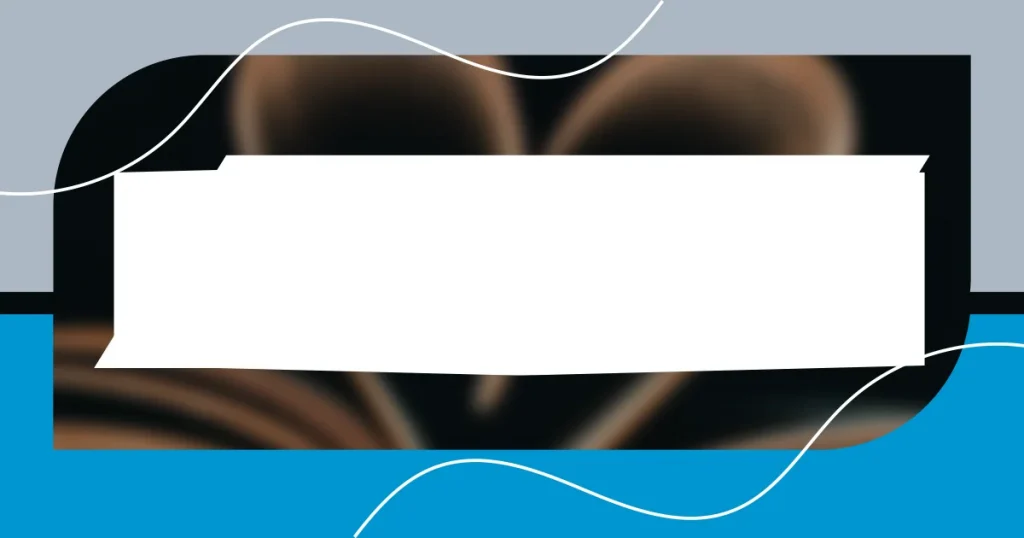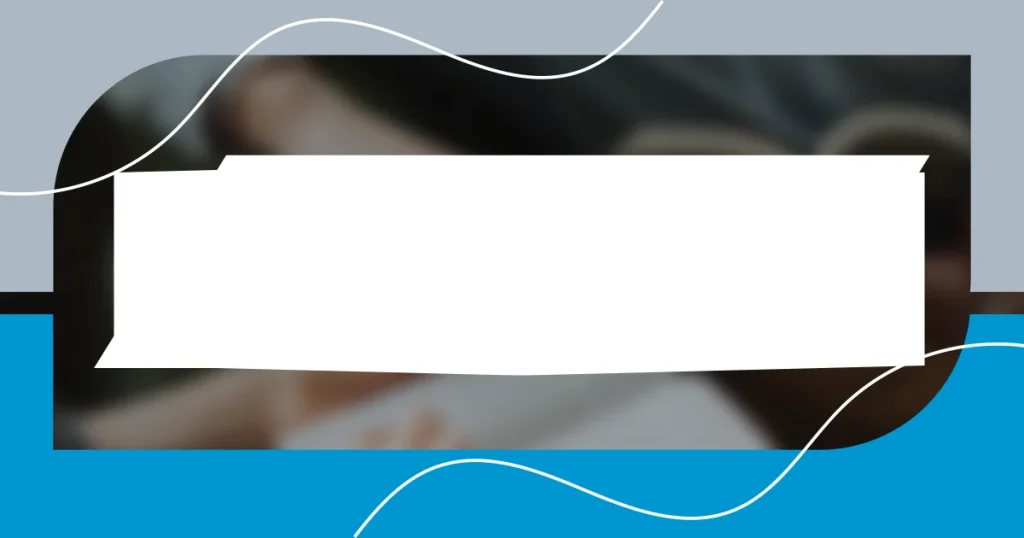Key takeaways:
- Effective editing involves a thorough preparation stage, including reading the manuscript, printing a copy, and creating a checklist to address common issues.
- Maintaining clarity and precision through careful word choice and logical structure is essential for enhancing the reader’s understanding and engagement.
- Finalizing the manuscript requires a comprehensive review for errors, consistency in style, and thoughtful arrangement of content to improve overall flow and impact.

Understanding the editing process
Editing a manuscript is like sculpting a block of marble; you chip away at the rough edges to reveal the beauty within. I often find myself immersed in this process, sometimes losing track of time. Has that ever happened to you? I think it’s fascinating how a second look can transform a piece of writing.
As I sift through my drafts, I focus not just on grammar or punctuation, but on tone, clarity, and flow. I remember a time when I received feedback on a story I loved; the suggestions were tough to digest initially, but they ultimately elevated my work. It made me realize that the editing phase is about embracing a fresh perspective. It’s about creating a dialogue between the writer’s intention and the reader’s experience.
During my editing journey, I often conceptualize it as a collaboration. The manuscript speaks back to me, revealing what works and what doesn’t. Have you ever read something and felt a disconnect? That’s the signal for me to step back and re-evaluate how to guide the reader through my narrative. Each edit is an opportunity to connect more deeply, and that connection is precisely what we’re striving for in the end.

Preparing the manuscript for editing
Before diving into the editing process, I always make sure to prepare the manuscript properly. This preparation can save a lot of time and frustration during the actual editing. I recall a time when I jumped straight into editing without organizing my work; it led to unnecessary confusion and multiple rounds of edits that could have been avoided.
Here’s what I typically do to get ready:
- Read through the entire manuscript to get a sense of the overall flow and tone.
- Print a physical copy if possible; there’s something about seeing words on paper that makes errors pop out at me.
- Create a checklist of common issues I want to address during editing, like passive voice or overused phrases.
- Take a break between writing and editing sessions to clear my mind; this fresh perspective can make a world of difference.
- Set specific goals for each editing session, such as focusing on character development or plot consistency.
Taking the time to prepare the manuscript not only sharpens the editing focus but also allows me to approach the work with renewed energy and clarity. Embracing this process has enriched my experience, making it a rewarding rather than a daunting task.

Evaluating the structure and flow
Evaluating the structure and flow is a critical step in the manuscript editing process. As I delve into the content, I find it essential to ensure that every paragraph transitions smoothly into the next. I once edited a manuscript where a sudden shift in perspective left readers confused and disoriented. This experience taught me the importance of maintaining coherence, making sure that the narrative either progresses logically or is clearly marked when a transition is necessary.
I also focus on the overall pacing of the manuscript. There’s a delicate balance between action and reflection. I recall editing a piece where the author rushed through pivotal emotional moments, leaving readers feeling detached. Taking the time to allow those moments to breathe not only enhances emotional engagement but also allows the story to unfold naturally. Reflecting on these elements helps in creating a manuscript that captivates the reader from start to finish.
In my experience, a helpful tactic is to read the manuscript aloud. This technique allows me to hear the rhythm and flow of the text, highlighting awkward phrasing or abrupt transitions. When I first tried this method, the difference was astonishing; it felt like untangling a knotted thread. This small change has proven invaluable in recognizing how each section of the manuscript contributes to the bigger picture.
| Aspect | Considerations |
|---|---|
| Flow | Ensure smooth transitions between paragraphs and ideas to maintain reader engagement. |
| Pacing | Balance action and reflection, allowing critical emotional moments to resonate. |
| Reading Aloud | Use this technique to catch awkward phrasing and improve overall rhythm. |

Enhancing clarity and precision
When I’m focused on enhancing clarity and precision in my editing process, I often find myself asking, “Does this sentence really convey what I want to say?” An example that stands out to me was an early draft where I used overly complex language to describe a simple idea. After some honest reflection, I rewrote it in simpler terms, stripping away unnecessary jargon. The revelation was like a light bulb moment; suddenly, the idea resonated much stronger with the reader.
I also pay close attention to word choice. There’s a world of difference between saying “utilize” and “use”—the latter is direct and impactful. In one manuscript, I noticed that the author frequently used vague phrases like “a significant amount.” By narrowing it down to specific figures or details, I could see how it sharpened the overall message. Precision isn’t just about getting the facts right; it’s about selecting words that resonate emotionally and intellectually with the reader.
Clarity often comes down to structure, too. I recall editing a story featuring a series of flashbacks that just felt jumbled. I experimented with reordering them and found that sequencing them logically made a profound difference. The narrative flowed seamlessly, guiding the reader through the character’s journey without confusion. It made me realize just how crucial it is to consider not only the content of each sentence but also its placement within the larger narrative.

Polishing grammar and punctuation
When it comes to polishing grammar and punctuation, I often remind myself that even the strongest ideas can fall flat without the right support. I remember an instance where I overlooked a simple comma splice in a manuscript. At first, I thought it was a minor detail, but when I revisited it, I realized how it disrupted the flow of my message. It’s fascinating how a tiny mark can wield so much power over clarity.
In my experience, consistency is key. There was a time I edited a document that alternated between American and British English spellings, which made it feel disjointed. I took the time to standardize everything, from “color” to “colour,” ensuring that the manuscript came across as a unified whole. This taught me that punctuation and grammar aren’t just technical details; they create a sense of professionalism and respect for the reader.
I often ask myself: how does punctuation serve the voice of the manuscript? I had a client once who tended to overuse exclamation marks, thinking they added excitement. However, when I shared my observations, we found that less was more. By sprinkling in a few strategic punctuation marks instead of saturating the text with exuberance, we heightened the emotional impact of the scenes. It’s incredible how fine-tuning these elements can elevate the entire work, helping it resonate more powerfully with readers.

Reviewing for consistency and style
Reviewing for consistency and style is something I genuinely enjoy because it brings a manuscript to life. I once edited a novel where the protagonist’s voice varied wildly from chapter to chapter. I realized that maintaining a consistent tone is essential; it keeps readers immersed in the story rather than jolting them with sudden shifts. I made it a point to match the protagonist’s reactions and thoughts to align with the overarching mood, and the resulting harmony was both satisfying and compelling.
The importance of style can’t be overstated. I often find myself pondering, “Is this line true to the author’s intention?” There was a short story I worked on where the author’s unique voice was buried under generic phrasing. By encouraging them to embrace their quirks—whether it be a playful turn of phrase or unconventional metaphor—we unlocked a vibrant narrative. The joy in seeing an author’s personality shine through is a reminder of why I love this process.
One approach I take is to create a checklist of stylistic elements, like ensuring consistent formatting around dialogue or character descriptions. I had a manuscript once where character actions were described in various ways: sometimes a “nod” and other times a “gesture”—it confused the reader. By standardizing these elements, not only did I tidy up the text, but I also noticed the characters started to feel more authentic. Isn’t it amazing how consistency can amplify a character’s presence? It’s those little things that can truly enhance the storytelling experience.

Finalizing the manuscript before submission
As I approach the finalization of a manuscript, I find it crucial to conduct a thorough read-through to catch those last-minute errors that can slip by unnoticed. I recall an instance when I felt I was ready to submit a manuscript, only to discover during my final review that a character’s name was misspelled in one of the chapters. It struck me how much we can become blind to our work after looking at it for too long. This moment taught me the importance of stepping back and viewing the manuscript with fresh eyes—using strategies like reading aloud or even changing the font can do wonders for spotting inconsistencies.
Another key area I focus on is formatting. I once edited a nonfiction book filled with important data and references. The author used different styles for each citation, which created unnecessary confusion. I took the time to align everything according to a specific style guide. It might seem tedious, but it not only made the manuscript more visually appealing but also enhanced its credibility. Have you ever noticed how a well-formatted document can draw you in? It holds the reader’s attention and underscores the author’s professionalism.
Finally, I often reflect on the overall flow of the manuscript. During one project, I rearranged several chapters to improve pacing and suspense. The story’s impact dramatically changed for the better! I truly believe that the order in which events are presented can either build tension or diffuse it. Isn’t it rewarding when a simple rearrangement transforms a good narrative into a compelling one? These final adjustments can breathe new life into a manuscript, making it not just ready for submission, but also ready to captivate an audience.
















